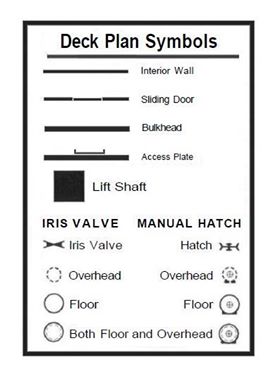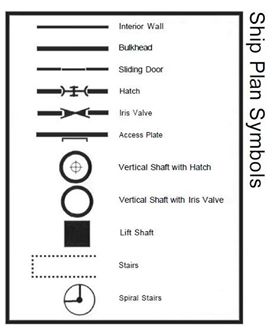Bulkhead Wall
Bulkhead Walls or simply Bulkheads are major structural components of a ship, which compartmentalize the ship for purposes of damage control and environmental maintenance.[1]
- A Bulkhead Wall is a strongly constructed partition within the hull of a ship and is a form of Ship Equipment
Description (Specifications)[edit]
Bulkheads: They also form the outer hull of the ship. Bulkheads are very difficult to destroy. A concerted effort with an energy weapon or explosive will hole a bulkhead sufficient to destroy pressure integrity and allow weapons to fire through after considerable damage has been inflicted. Large amounts of damage, may create a hole large enough for a sophont to pass through. Bullet-firing weapons are most often ineffective against bulkheads. [2]
All deck floors are assumed to be bulkheads.[3]
Bulkheads are constructed of heavy metal – generally the same material from which the hull is constructed – and serve several purposes:
- They increase the structural rigidity of the vessel,
- They are fire- and damage-resistant.
- They create airtight compartments that can be sealed in the case of a hull breach or other emergency,
Decks are bulkhead walls.
A bulkhead can be holed, allowing pressure equalization between its two sides.
- If a path of holed bulkheads (or open hatches, doors, or non-airtight walls) can be traced from a location in the ship to vacuum, then all locations along that path become vacuum, resulting in explosive decompression.
- It takes a substantial amount of damage to a bulkhead wall to create an opening large enough for a human to fit through.
Image Repository[edit]
| Deck Plan Symbols | |
|---|---|
| Late Key Diagram | Early Key Diagram |

|

|
Hatches[edit]
A hatch is a hinged metal door set into a bulkhead. A hatch is airtight and must be operated by a handwheel set in its face. There is generally no provision for locking a hatch, but it may be blocked in a closed position by jamming an object (such as a blade, a bar, etc) into the handwheel mechanism.
- A hatch may be a doorway in a bulkhead wall or may be set flush in a deck.
Iris Valves[edit]
Iris Valves are always set in bulkhead walls or decks. Iris valves are airtight when closed and Iris valves will function automatically to seal off an area if pressure drops.
Access Plates[edit]
Access Plates are concealed maintenance or access panels that are intended for use by authorized personnel; they are inset in walls or bulkheads. Opening a panel requires the possession of a key.
Elevator Shafts[edit]
Elevator Shafts may run through bulkhead decks. The shaft passing through the bulkhead seals airtight after the elevator carriage has traveled through.
History & Background (Dossier)[edit]
Some sophonts such as the K'kree may forego internal bulkhead walls altogether, instead opting for large open spaces within their ships. Vessels constructed in this manner are far more prone to the effects of internal explosions or catastrophic explosive decompression.
Partition Walls are lighter structures typically used to demark staterooms and other internal features. They are not airtight.
References & Contributors (Sources)[edit]
- Snapshot Rules Booklet, Game Designers Workshop 1979
- Azhanti High Lightning Rules Booklet, Game Designers' Workshop 1980
- Jordan Weisman. "Book 2." Adventure Class Ships Volume 1 (1982): TBD.
- T5 Core Rules, Far Future Enterprises 2013
- Traveller Wiki Editorial Team
- Author & Contributor: Lord (Marquis) and Master Scout Emeritus Adie Alegoric Stewart of the IISS
- Author & Contributor: Lord (Marquis) and Master of Sophontology Maksim-Smelchak of the Ministry of Science
- ↑ Jordan Weisman. "Book 2." Adventure Class Ships Volume 1 (1982): 4.
- ↑ Jordan Weisman. "Book 2." Adventure Class Ships Volume 1 (1982): 4.
- ↑ Jordan Weisman. "Book 2." Adventure Class Ships Volume 1 (1982): 4.
